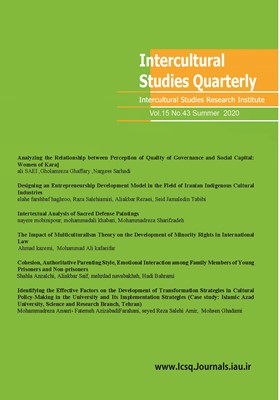Intertextual Analysis of Sacred Defense Paintings
Subject Areas : INTERCULTURAL STUDIES QUARTERLY
nayere mobinipour
1
,
mohammadali khabari
2
,
Mohammadreza Sharifzadeh
3
![]()
1 - PhD Student in Comparative History of Comparative Islamic Art, Central Tehran Branch, Islamic Azad University, Tehran, Iran
2 - Assistant Professor, Art Research Group, University Jihad, Tehran, Iran.
3 - Associate Professor, Department of Philosophy of Art, Central Tehran Branch, Islamic Azad University, Tehran, Iran
Keywords: Discourse, intertextuality, Discourse Analysis, holy defense, Holy Defense Painting,
Abstract :
To read a text, you need previous and contemporary texts, and no text is independent of its predecessors. Since every work of art is a text, a painting can also be considered a text. Due to the appropriateness of Gerard Genet's intertextual theory with the subject, it has been used as a theoretical framework. The painting of the Holy Defense has its own semantic and aesthetic system that is different from each other. Tastes both in the production and in the acceptance of works of art change depending on the social transformation that has taken place in terms of the structural nature of the work under study. This article intends to answer the questions of how the painting of the Holy Defense was able to represent this subject through text and image and convey it to the audience and how to describe it in the form of aesthetics. The method is fundamental in terms of purpose and based on historical, descriptive and analytical methods in terms of nature. Considering the study of sacred defense paintings and semantics and the reproduction of the sacred concept of war by paintings (texts) and how the concept of sacred warfare is reproduced by images and their role in the reproduction and desecration of war is presented as the final result.
آلن، گراهام (1385). بینامتنیت، ترجمه پیام یزدان جو، تهران: نشر مرکز.
احمدی، بابک (1375). از نشانه های تصویری تا متن، تهران: چاپ دوم، نشر مرکز.
اسماعیلی، احسان (1391). دریافت بینامتنی نقاشان معاصر از ادبیات کلاسیک، دانشگاه هنر اصفهان.
خانی، مینو ( 1395)رنگ جنگ ایران و عراق، پاریس: ارمتان.
خطیـب، پریســا (1390). مطالعــه بینــامتنی غزلیـات شــمس از منظــر نقاشـی مــدرن ایران،دانشگاه الزهرا.
ژنـت، ژرار (1397). گفتمـان روایـت (جسـتاری در بـاب روش)، ترجمـه معصــومه زواریان، تهران: سمت
سلطانی، سید علی اصغر (1384). قدرت، گفتمان و زبان، تهران: نشر نی.
سلمانی، محمدعلی و یاری، علی اصغر و قاسمیان نسب، راضیه (1390) . « بینامتنی شعر بدوی جبل با قرآن کریم»، فصلنامه لسان مبین،(2)6.
فر کلاف نورمن (1398). تحلیـ ل گفتمـان انتقـاد ی، متـرجم روح االله قاسـم ی، تهـران : اندیشه احسان
کنگرانی منیژه و بهمن نامور مطلق ( 1398). « گونه شناسی روابط بینامتنی و بیش متنـی در شعر فارسی نقاشی ایرانی»، نخستین مقالات هماندیشـی زبـان و مطالعـات بینارشـته ای ادبیات و هنر، تهران: چاپ اول فرهنگستان هنر.
گودرزی مصـطفی، گردآورنـد ه ( 1368) .« خیـال شـرقی»، کتـاب تخصصـی هنرهـای تجسمی، پژوهش گفت وگو نقد گزارش علمی، تهران: فرهنگستان هنر.
محمدزاده، فرشته (1396). تحلیل بینامتنی راحت الصدور و شاهنامه بر مبنای ترامتنیت ژرار ژنت، دانشگاه فردوسی.
محمدی اردکانی، جوادعلی (1398). تحلیل بینامتنی متن و نگاره های نسخه خطی 996ه.ق دیوان جیبی اکبرشاه با تاکید بر نظریه ترامتنیت ژرار ژنت. دانشگاه علم و فرهنگ تهران.
مرکز هنرهای تجسمی، حوزة هنری (1391). ردپای نور، مروری بر آثار منتخب نقاشی و گرافیک.
نامور مطلق، بهمن (1395). از ساختارگرایی تا پسامدرنیسم، تهران: نشر سخن.
نامور مطلق، بهمن (1390). درآمدی بر بینامتنیت نظریه ها و کاربردها، تهران: نشرسخن.
Allen. Graham (2000). Intertextuality. London: Routhedge .Economic Damges of the War Imposed by Iraq on Islamic epublic of Iran (1980-1988). Tehran: Islamic Republic of Iran, 1991
Kristeva, J (1984). Revolotion in poetic Language. Trans. Leons.Roudiez. NewYork: Colombia University Press
Poulin. Jacques (1988). Volkswagen Blues. Montreeah: Lemeas
Menashri, David(1990). Iran: A Decade of war and Revolution Newyourk: Holmes & Meiere Publiscers Inc.
_||_


